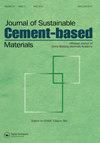A simple method for quantifying the size effect on fiber orientation distribution functions (ODFs) in fiber-reinforced concrete
IF 4.2
3区 工程技术
Q1 CONSTRUCTION & BUILDING TECHNOLOGY
Journal of Sustainable Cement-Based Materials
Pub Date : 2022-12-02
DOI:10.1080/21650373.2022.2151054
引用次数: 0
Abstract
Fiber orientations are constrained by boundary effects (e.g. size effect), which play a significant role in the macroscopic rigidity of fiber-reinforced concrete (FRC). However, how to quantify the size effect on the fiber orientation distribution functions (ODFs) remain to be open issues. In this work, a simple method to quantify the sectional-size impact on fiber ODFs is proposed. By disassembling the fiber rotatable range and fiber location on the cross-section into several small facets and points, respectively, we draw out the fiber ODFs with different sectional sizes through superposition. Then, the calculation method of the fiber orientation factor based on the ODF is proposed, and the framework of applying an ODF to calculate the stiffness matrix is given. Our results revealed the influence of the cross-section size on the elastic properties of FRC, which can provide a sound guidance for the design and optimization of fiber-based cement composites. Highlights 1. A practical method for discretizing the cross-section of fiber-reinforced concrete (FRC) into a point set is proposed. 2. A quantitative interplay between boundary constraints and size effects on fiber ODFs is developed. 3. The calculation framework of the fiber orientation factor and elastic modulus of the FRC based on the ODF is established. 4. The difference between the effective elastic modulus and Poisson’s ratio of FRCs with different boundary constraints is discussed.一种量化纤维增强混凝土中纤维取向分布函数(odf)尺寸效应的简单方法
纤维取向受边界效应(如尺寸效应)的约束,对纤维增强混凝土(FRC)的宏观刚度起重要作用。然而,如何量化尺寸对光纤取向分布函数(odf)的影响仍然是一个悬而未决的问题。在这项工作中,提出了一种简单的方法来量化截面尺寸对光纤odf的影响。我们将光纤的可旋转范围和光纤在截面上的位置分别分解成几个小平面和小点,通过叠加得到不同截面尺寸的光纤odf。然后,提出了基于ODF的纤维取向因子的计算方法,并给出了应用ODF计算刚度矩阵的框架。研究结果揭示了截面尺寸对FRC弹性性能的影响,可为纤维基水泥复合材料的设计和优化提供良好的指导。亮点1。提出了一种实用的纤维增强混凝土截面离散成点集的方法。2.研究了边界约束和光纤odf尺寸效应之间的定量相互作用。3.建立了基于ODF的纤维取向系数和纤维纤维弹性模量的计算框架。4.讨论了不同边界约束下frp的有效弹性模量和泊松比的差异。
本文章由计算机程序翻译,如有差异,请以英文原文为准。
求助全文
约1分钟内获得全文
求助全文
来源期刊
CiteScore
6.60
自引率
15.90%
发文量
71
期刊介绍:
The Journal of Sustainable Cement-Based Materials aims to publish theoretical and applied researches on materials, products and structures that incorporate cement. The journal is a forum for discussion of research on manufacture, hydration and performance of cement-based materials; novel experimental techniques; the latest analytical and modelling methods; the examination and the diagnosis of real cement and concrete structures; and the potential for improved cement-based materials. The journal welcomes original research papers, major reviews, rapid communications and selected conference papers. The Journal of Sustainable Cement-Based Materials covers a wide range of topics within its subject category, including but are not limited to: • raw materials and manufacture of cement • mixing, rheology and hydration • admixtures • structural characteristics and performance of cement-based materials • characterisation techniques and modeling • use of fibre in cement based-materials • degradation and repair of cement-based materials • novel testing techniques and applications • waste management

 求助内容:
求助内容: 应助结果提醒方式:
应助结果提醒方式:


